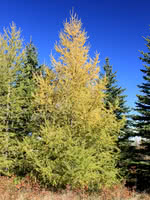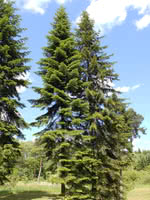Mon-Fri 9am - 5pm Mountain time
Siberian Larch vs Siberian Fir
Larix sibirica
Abies sibirica
COMING SOON
(new stock expected: later this season)
Siberian Larch is a large, cold hardy conifer. Like the Tamarack, its needles turn golden yellow and drop in the fall, and it is able to handle saturated soils.
If you are looking for a long-lived tree for your large property or shelterbelt with quite wet soil, this is the tree for you.
This variety is often used on the south side of a shelterbelt to let sunlight in during the winter and to provide protection or shading during the summer.
Siberian Fir is an evergreen tree best known for its strong aroma. This tree's needles are popular for essential oils and aromatherapy. It also grows softwood that is used for furniture and wood pulp. This species is very cold hardy and shade tolerant.
This species is bright green and conical shaped. Most interesting is its upright blue cones that fade into brown as they mature.

